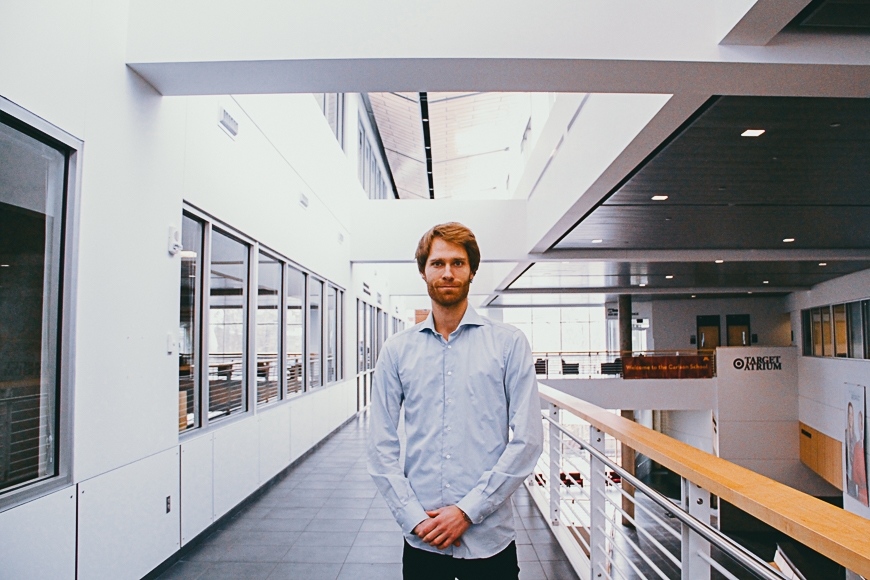Money Matters in Health and Longevity
The saying goes that money can’t buy happiness. But graduate student Vegard Nygaard is looking at the question of whether it could, in fact, buy health.
Health by the Numbers
Nygaard has been researching the relationship between income and life expectancy.
“It’s interesting. If you look at the data, you see a 10-15 year life expectancy difference between the richest and the poorest Americans, which is an enormously large difference,” says Nygaard.
In his research, Nygaard studies how a person’s life expectancy depends on their health behavior, income, and insurance coverage by using data collected from the Medical Expenditure Panel Survey and the Health and Retirement Study. He then uses this data to quantify the effect of tax and health insurance reforms on the difference in life expectancy between high- and low-income Americans through the use of a theoretical model.
Due to the combination of microdata and the macroeconomic models from his Minnesota Economics training, his research is able to focus both on the factors that determine the differences in life expectancy and on policy reforms that could increase life expectancies for those who currently have the lowest.
“I think it’s a really important question to figure out why we have such large differences in life expectancy across income groups,” he says.
From Oslo to Minneapolis
Even as a young economics student at the University of Oslo in Norway, Vegard Nygaard knew he wanted to pursue a PhD.
He chose to attend the University of Minnesota because of its renowned macroeconomics program. “One of my advisors at the University of Oslo worked at the University of Minnesota for a brief period of time and encouraged me,” says Nygaard and adds, “I thought Minnesota was a good fit for me and I’ve really enjoyed it so far!”
Because the Department of Economics is on the smaller side, Nygaard believes that graduate students benefit enormously from the direct contact with professors and other faculty members. Professors practice an “open-door policy” that makes it easier for students to approach them with questions or for guidance.
Moreover, the connection between the Federal Reserve Bank of Minneapolis and the department allows students to interact with world-leading macroeconomists. “The Federal Reserve Bank of Minneapolis is such a unique place. It’s probably one of the best places in the world to do macroeconomic research,” says Nygaard, who, as a research assistant for Professor Timothy Kehoe, has a desk at the Federal Reserve Bank of Minneapolis.
Every Tool Available
Nygaard realized early in life that he quite enjoyed problem-solving and using “every tool available” to attack puzzling, so far unanswered, questions. Today, as a sixth-year graduate student, Nygaard is searching for policy reforms to tackle the problem of a burgeoning life expectancy inequality across income groups.
Nygaard quickly realized that the problem at hand required more than just data and more than a theoretical model. This led him to a year-long project characterized by microdata collection, data analysis, and model development to reach the results he can talk about today.
The Beginning
Nygaard, who started out as a trade economist, says that he developed an interest in this topic during his third year as a PhD student. His advisor, Professor Timothy Kehoe, asked him to be a research assistant for one of his projects on the macroeconomic consequences of increasing health care costs and an aging population.
Nygaard hadn’t anticipated developing such a fascination for the field and altered his own research to explore it more. “Originally, I expected to only work on health projects for my research assistantship and to focus on trade for my own research, but I quickly became fascinated with the field, which led me to the work I do today,” states Nygaard.
His interest in this topic can be attributed to the cloud of political chatter around healthcare and welfare programs in the United States for the past few years. “It’s an interesting thing for researchers because suddenly healthcare has changed dramatically [due to the introduction of the Affordable Care Act],” notes Nygaard. “This allows researchers to analyze the effects of large healthcare reforms in the country and be able to propose policy reforms accordingly.”
A Picture of (Future) Health
His tenacity for tackling these questions has earned him a doctoral dissertation fellowship this year that gives the University’s most talented PhD students the chance to complete their research and finalize their dissertation.
“My research has already provided evidence that giving people health insurance will have positive health effects. In my dissertation, I show that a universal health insurance reform would lead to increased life expectancies for those who currently have the lowest life expectancies. It would also reduce healthcare spending and increase income since it would improve the population’s health.
“At the moment, I am analyzing how tax reforms such as a reduction in taxes for low-income Americans would impact life expectancy inequality. My current findings seem to suggest that such tax reforms would indeed decrease inequality of life expectancy in the United States.”
This story was written by an undergraduate student in CLA.



